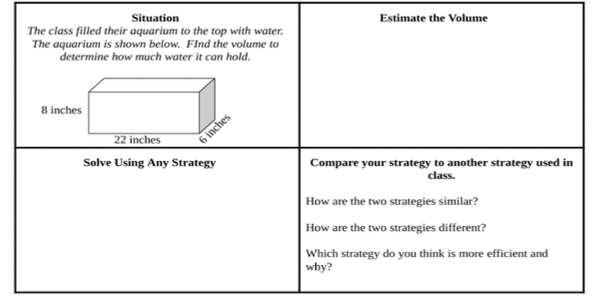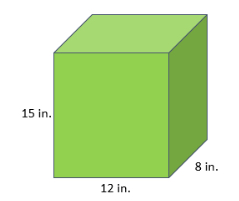General Information
Benchmark Instructional Guide
Connecting Benchmarks/Horizontal Alignment
Terms from the K-12 Glossary
- Rectangular Prism
Vertical Alignment
Previous Benchmarks
Next Benchmarks
Purpose and Instructional Strategies
- The purpose of this benchmark is for students to make connections between packing a right rectangular prism with unit cubes to determine its volume and developing and applying a multiplication formula to calculate it more efficiently. Students have developed experience with area since grade 3 (MA.3.GR.2.2). For volume, side lengths are limited to whole numbers in grade 5, and problems extend to fraction and decimal side lengths in grade 6 (MA.6.GR.2.3).
- Instruction should make connections between the exploration expected of MA.5.GR.3.1 and what is happening mathematically when calculating volume (MTR.2.1).
- Instruction should begin by connecting the measurement of a right rectangular prism to the calculation of a rectangle’s area. The bottom layer of the prism is packed with a number of rows with a number of cubes in each, like area of a rectangle is calculated with unit squares. From there, the third dimension (height) of the prism is calculated by the number of layers stacked atop one another.
- Having students explore how volume is calculated helps students see the patterns and develop a multiplication formula that will help them make sense of the two most common volume formulas, V = B × h (where B represents the area of the rectangular prism’s base) and V = l × w × h. If students understand conceptually what the formulas mean, they are more likely to use them effectively and efficiently (MTR.5.1).
- When students use a multiplication formula, it is important for them to see that it is a matter of choice which dimensions of rectangular prisms are named length, width and height. This will help students understand that when calculating the volume of a rectangular prism, the three dimensions are multiplied together and that the order of factors does not matter (commutative property of multiplication).
Common Misconceptions or Errors
- Students may confuse the difference between b in the area formula A= b X h and B in the volume formula V = B × h. When building understanding of the volume formula for right rectangular prisms, teachers and students should include a visual model to justify their calculations.
- Students may make computational errors when calculating volume. Encourage them to estimate reasonable solutions before calculating and justify their solutions after. Instruction can also encourage students to find efficient ways to use the formula.
- For example, when calculating the volume of a rectangular prism using the formula V = 45 × 12 × 2, students may find calculating easier if they multiply 45 × 2 (90) first, instead of 45 × 12. During class discussions, teachers should encourage students to share their strategies so they can build efficiency.
Strategies to Support Tiered Instruction
- Instruction includes differentiating between base in the area formula, Area = b × h and base in the volume formula Volume = B × h. Teacher provides students with models of two-dimensional figures, and three-dimensional figures, and has them identify which formula they will use and what the base in each image is.
- For example, the students highlight the lines included in the base measurement for each figure. Then, they use the base to calculate the area or volume. The teacher provides students with a set of models like the one shown below asking which image they would use the area formula for and which image they would use the volume formula for. Students then highlight the measurements used for the base in the formula. For the first figure, students would use volume and the formula B × h with B = 16 × 4. For the second figure, students would find area and use the formula b × h with b = 16.

- Instruction includes providing models of two-dimensional and three-dimensional figures with the area and volume formula labeled and color-coded with the measurements.
- For example, the teacher provides students with the following set of visual models and has students explain the difference in the base measurement in each formula. Students calculate the area or volume of each figure using the formula.

- Instruction includes providing a graphic organizer that requires students to estimate the volume of real-world examples provided and then solve using any strategy they would like.
- For example, the teacher provides students with a graphic organizer similar to the one shown below. Students use it to find the volume of the given example and then compare their strategy to others.

- Instruction includes finding efficient ways to use the formula.
- For example, when calculating the volume of a rectangular prism using the formula V = 45 × 12 × 2, students may find calculating easier if they multiply 45 × 2 (which equals 90) first, instead of 45 × 12. During class discussions, teachers should encourage students to share their strategies so they can build efficiency.
- Instruction includes providing worked examples of volume and having students determine which strategy is the better strategy to use and why.
- For example, the teacher provides students with the following image and two examples of how students solved for volume. Student A solved the area of the base first using the Distributive Property to help with the multiplication. Student B used the Associative Property of Multiplication and multiplied 20 × 5 first. Students discuss both strategies and explain which would be easier and why.

Instructional Tasks
Instructional Task 1 (MTR.2.1)
The Great Graham Cracker Company is looking for a new package design for next year’s boxes. The boxes must be a right rectangular prism and measure 144 cubic centimeters.- Part A. What are three package designs the company could use? Draw models and write equations to show their volumes.
- Part B. Dr. Cruz, the company’s founder, wants the height of the package to be exactly 8 centimeters. What are two package designs that the company can use? Draw models and write equations to show their volumes.
Instructional Items
Instructional Item 1
Which of the following equations can be used to calculate the volume of the rectangular prism below?
- a. V=96×15
- b. V=15×8×12
- c. V=15×20
- d. V=27×8
- e. V=23×12
Instructional Item 2
A bedroom shaped like a rectangular prism is 15 feet wide, 32 feet long and measures 10 feet from the floor to the ceiling. What is the volume of the room?- a. 57 cubic ft.
- b. 150 cubic ft.
- c. 4,500 cubic ft.
- d. 4,800 cubic ft.
*The strategies, tasks and items included in the B1G-M are examples and should not be considered comprehensive.
